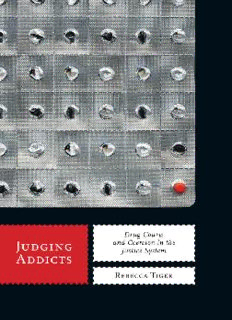
Judging Addicts: Drug Courts and Coercion in the Justice System PDF
Preview Judging Addicts: Drug Courts and Coercion in the Justice System
Judging Addicts Alternative Criminology Series General Editor: Jeff Ferrell Pissing on Demand: Workplace Drug Graffiti Lives: Beyond the Tag in New Testing and the Rise of the Detox York’s Urban Underground Industry Gregory J. Snyder Ken Tunnell Crimes of Dissent: Civil Disobedience, Empire of Scrounge: Inside the Urban Criminal Justice, and the Politics of Underground of Dumpster Diving, Conscience Trash Picking, and Street Scavenging Jarret S. Lovell Jeff Ferrell The Culture of Punishment: Prison, Prison, Inc.: A Convict Exposes Life Society, and Spectacle inside a Private Prison Michelle Brown by K.C. Carceral, edited by Thomas Who You Claim: Performing Gang J. Bernard Identity in School and on the Streets The Terrorist Identity: Explaining the Robert Garot Terrorist Threat 5 Grams: Crack Cocaine, Rap Music, Michael P. Arena and Bruce A. Arrigo and the War on Drugs Terrorism as Crime: From Oklahoma Dimitri A. Bogazianos City to Al-Qaeda and Beyond Judging Addicts: Drug Courts and Mark S. Hamm Coercion in the Justice System Our Bodies, Our Crimes: The Policing Rebecca Tiger of Women’s Reproduction in America Jeanne Flavin Judging Addicts Drug Courts and Coercion in the Justice System Rebecca Tiger a new york university press New York and London NEW YORK UNIVERSITY PRESS New York and London www.nyupress.org © 2013 by New York University All rights reserved References to Internet websites (URLs) were accurate at the time of writing. Neither the author nor New York University Press is responsible for URLs that may have expired or changed since the manuscript was prepared. Library of Congress Cataloging-in-Publication Data Tiger, Rebecca. Judging addicts : drug courts and coercion in the justice system / Rebecca Tiger. p. cm. Includes bibliographical references and index. ISBN 978-0-8147-8406-8 (cl : alk. paper) ISBN 978-0-8147-8407-5 (pb : alk. paper) ISBN 978-0-8147-5941-7 (ebook) ISBN 978-0-8147-8596-6 (ebook) 1. Drug courts—United States. 2. Duress (Law)—United States. 3. Drug abuse— Treatment—Law and legislation—United States. 4. Drug addicts—Legal status, laws, etc.— United States. I. Title. KF3890.T54 2012 345.7302770269—dc23 2012024946 New York University Press books are printed on acid-free paper, and their binding materials are chosen for strength and durability. We strive to use environmentally responsible suppliers and materials to the greatest extent possible in publishing our books. Manufactured in the United States of America c 10 9 8 7 6 5 4 3 2 1 p 10 9 8 7 6 5 4 3 2 1 For Richard Schoenwald, who taught me how to ask questions This page intentionally left blank Contents Acknowledgments ix Introduction 1 Both Bad and Sick 15 Criminalizing Deviance: Reconciling the Punitive and Rehabilitative 41 “The Right Thing to Do for the Right Reasons”: The Institutional Context for the Emergence of Drug Courts 58 “Enlightened Coercion”: Making Coercion Work 73 “Force Is the Best Medicine”: Addiction, Recovery, and Coercion 88 “Now That We Know the Medicine Works”: Expanding the Drug Court Model 115 Conclusion 133 Appendix 151 Notes 157 Bibliography 173 Index 183 About the Author 198 vii This page intentionally left blank Acknowledgments THIS BOOK WAS long in the making, and it reflects the help of many people who pushed me to think critically about drugs, addiction, and soci- ety—and people who made my life fun amid the work. The late Robert Alford was instrumental in pushing me to articu- late the “contradictory institutional logics” that I witnessed in my public health work. When Bob died in 2003, the world lost an amazing sociolo- gist and exemplary mentor. My thinking has been stamped with his unique and critical approach to the social world. Barbara Katz Rothman was the dream adviser; she agreed to oversee a project about which she knew little but still managed to push me to focus on the knowledge that made coerced treatment possible. Barbara has also become a good friend, and she still lets me call on her regularly for advice. Bill Kornblum and Michael Jacob- son both enthusiastically supported this research. Bill encouraged me to be clear and Michael, as always, to articulate this project’s “so what?” John Torpey pushed me to view this project historically. Without my regular conversations with John about the history of punishment and discipline, I don’t think I would have figured out the answer to Michael’s persistent question. Carroll Seron enthusiastically discussed my project with me, and provided much-needed encouragement. CUNY Graduate Center gener- ously supported my research. I was fortunate to receive a fellowship from the National Institute on Drug Abuse that funded me. Many people involved with this fellowship at the National Development and Research Institutes provided invaluable feedback on my work. Greg Falkin and the late Bruce Johnson consistently supported me during my five years in the program. Other fellows whole- heartedly encouraged my critical approach to coerced treatment, and with- out them, I don’t think I would have finished this project. Dina Perrone, in particular, provided much-needed intellectual and emotional support. She still does. Conversations with Rebecca DeGuzman confirmed that “critical addiction studies” does matter; I am thankful for the compatibility of our worldviews. Azure Thompson’s astute critiques of my writing cer- tainly strengthened mine. I am always inspired by conversations with Ker- win Kaye, whose stellar research with people coerced into drug treatment pushed me to think more critically about many of my book’s conclusions. ix
Description: